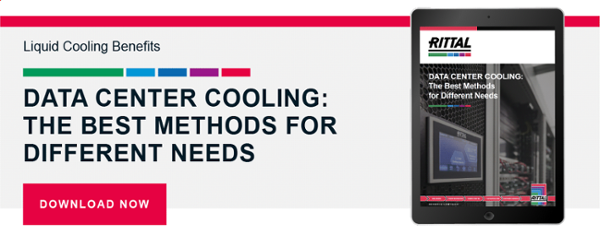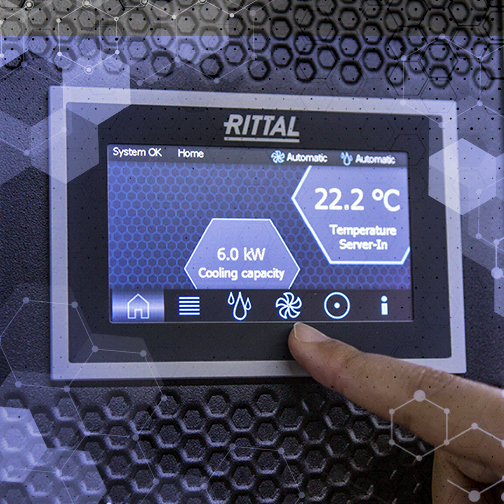Intro:
As demand for more data and more bandwidth continues, so does the demand for more efficient cooling. Watch the video or read the transcript to get a better understanding of the best option for keeping your data center cool and running at peak performance.
Video Transcript:
Growing Data Demands Require a Better Cooling Solution
Hello, Kyle Fragala with Rittal North America here to take a few minutes and talk about liquid cooling solutions for the data center. Now, it should be no surprise to anyone here that the demand for data and bandwidth continues to increase, right? And the drivers for this demand are the usual suspects: hyper connectivity with 5g, and Edge, AI, Virtual Reality, Augmented Reality, machine learning, IoT... to name a few, but especially the exponential increase in cloud computing, with the now commonplace remote work and digital school environments really contributing to the surge. When you combine this with an increase in processing power from next-generation servers, data center operators are working really hard to address this need for additional cooling capabilities.
And oftentimes, these operators must address these needs without the luxury of major investments in infrastructure upgrades, or maybe more importantly, without disruption to the operation. Localized cooling, specifically liquid cooling, may provide the best option. Studies have shown that liquid cooling solutions are far more capable and efficient than air cooled systems. They're extremely flexible and that most are plugged, plumb and play. And oftentimes, they have little to no impact on existing infrastructure. These systems can be designed on Day One as standalone systems or they can be added and retrofitted to address a specific hotspot or to support that higher density application. They target the heat source directly and locally and they can be managed independently from the overall data center providing very precise monitoring and control.
Let’s Talk Liquid Cooling
Now, there are several types of liquid cooling solutions. For example, you've got in-row cooling units, both in the water-based and DX versions. You've got in-rack cooling units, such as rear-door heat exchangers and self-contained air conditioning units. You've got direct-to-chip and evaporative cooling. You also have immersion systems. Now, each of these solutions has its own merits and its ideal application. And their use really depends on the facility and the existing infrastructure and its layout.
One of the most versatile of these solutions is the in-row unit, specifically Rittal’s LCP DX 20 kW unit, which is a direct-expansion unit that utilizes a very environmentally friendly and low-impact R410A refrigerant. It's a sidecar design unit with a footprint of only 12 inches wide. It's ideal for placement within a row or some other constrained space. Its flexibility allows for deployment across virtually any environment you can think of from the raised-floor white space to a concrete slab to a data closet in an office environment, a manufacturing facility or plant floor environment, to even a container. And with its range from 5 kW to 20 kW, it provides a level of future proofing. For example, if you have a single unit with two cabinets, you can get up to 10 kW per cabinet shared load. Once you begin to exceed that load, you simply add another cooling unit which makes it unnecessary to spend up front per planned capacity or expected capacity. Rather just pay as you grow.
And as I mentioned before, the LCP DX certainly excels when it's used across a variety of environments. Being a direct expansion unit, its only consideration is the placement of its condenser unit. It's really easily relocated, making moves, adds and changes extremely simple. And with its included SNMP card, the network connectivity is built in so that you can monitor performance of the system no matter where it gets installed. They are extremely economical when you compare them to the larger downflow cooling strategies. And I think when you add all of this up, the Rittal LCP DX 20 kW is a solution that's more than worthwhile to consider on your next project. Should you have a requirement that’s more than 20 kW per unit, check out our chilled water-based LCP units that can achieve up to 55 kW – that’s 55 kilowatts of cooling per unit in the same 12-inch wide footprint.
If you have any questions or for any more information on the LCP DX 20 kW unit, please contact Rittal’s Inside Support Service Group at 847-240-4630. Rittal is a leading global supplier of liquid cooling products, cabinet infrastructure and power distribution, offering a comprehensive portfolio of products from hyperscale to the hyperlocal. Rittal can meet the most demanding installation requirements. We offer services from design and engineering through to installation and service, so please let us know what we can do to help you with your next project. Thanks for tuning in, talk to y'all soon. Take care.
Learn more about Liquid Cooling by reading our Data Center Cooling: The Best Methods for Different Needs whitepaper.



